Holistic Treatment For Osteosarcoma In Dogs
Natural Remedies for Bone Cancer in Dogs
Why Use Natural Supplements for Canine Osteosarcoma?
Ask Ariel's supplements for dogs with bone cancer can be used along with conventional treatments prescribed by your veterinarian. Our natural remedies can help your dog in three different ways:
- Helps relieve pain and inflammation.
- Supports immunity to help your pup fight cancer.
- Helps strengthen the bones and ligaments.
.png)
Happy Paws Organic Hemp Extract For Dogs is a professional veterinary strength CBD oil that can help reduce pain and inflammation and support a healthy immune system. Happy Paws CBD oil is the #1 choice for dogs with cancer. Controlling inflammation is a core part of cancer treatment and that is the main characteristic of this dog bone cancer oil. The ingredients in Happy Paws are being researched for their ability to reduce metastasis and cancer growth in certain types of cancer. There is promising research* being funded by the American Kennel Club Canine Health Foundation that shows a significant decrease in cancer cell reproduction when CBD is used alone or in combination with chemotherapy drugs. Anecdotal reports also include reduced pain, inflammation and discomfort. Each 1oz bottle contains 550mg of full-spectrum hemp extract in an unflavored all-natural coconut-oil base. It’s 100% organic and made in the USA.
*The Effect of Cannabidiol on Canine Neoplastic Cell Proliferation and Mitogen-Activated Protein Kinase Activation During Autophagy and Apoptosis. Veterinary and Comparative Oncology. Volume 19, Issue 2, June 2021
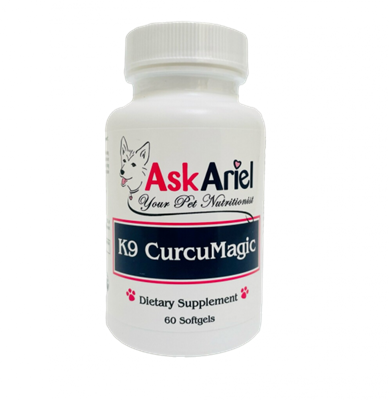
K9 CurcuMagic is a scientifically proven, natural anti-inflammatory pet supplement containing a patented combination of three curcuminoids and turmeric essential oil acting as free-radical scavengers. These cancer-fighting nutrients in this unique bioactive turmeric formula help pets prevent and fight cancer. K9 CurcuMagic absorbs best when digested with fat, especially omega-3 fatty acids (found in Amazing Omegas), which is why our clients use the two pet cancer supplements together. If your pet is undergoing radiation, curcumin can protect the skin during radiation. Herbal supplements for dogs with bone cancer can provide natural pain relief.
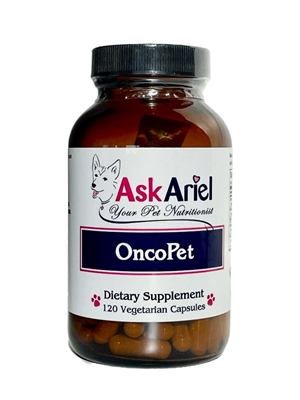
OncoPet Cancer Vitamin For Dogs is a proprietary blend of herbs and medicinal mushrooms that provide powerful immune support. The natural ingredients in OncoPet contain polyphenols, beta-glucans and antioxidants, like D-fraction and L-ergothioneine, that boost the immune system and help regulate your dog's inflammatory response. OncoPet is a comprehensive dog cancer vitamin that also includes herbs to help balance the gut microbiome and reduce nausea and cancer-related fatigue. Combines well with cancer treatments from your veterinarian or veterinary oncologist. Helps pets handle chemotherapy and radiation. Excellent value. One bottle lasts up to 8 months for small dogs.
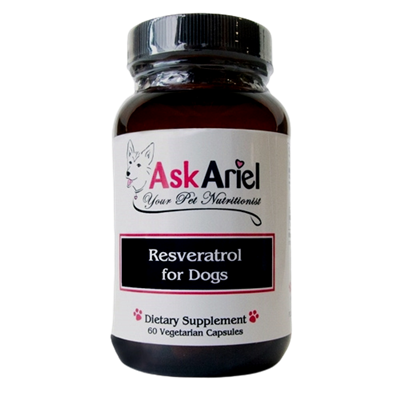 Resveratrol for Dogs is an exceptional antioxidant, backed by research, that promotes cartilage, disc and joint health. Resveratrol research suggests that it can help protect bones and cartilage from breaking down and may help relieve joint pain. Resveratrol may also help fight cancer by inhibiting the growth of cancer cells and targeting free radicals. Resveratrol for Dogs also supports immune function and provides excellent natural cancer support for dogs. Resveratrol for Dogs is an exceptional antioxidant, backed by research, that promotes cartilage, disc and joint health. Resveratrol research suggests that it can help protect bones and cartilage from breaking down and may help relieve joint pain. Resveratrol may also help fight cancer by inhibiting the growth of cancer cells and targeting free radicals. Resveratrol for Dogs also supports immune function and provides excellent natural cancer support for dogs.
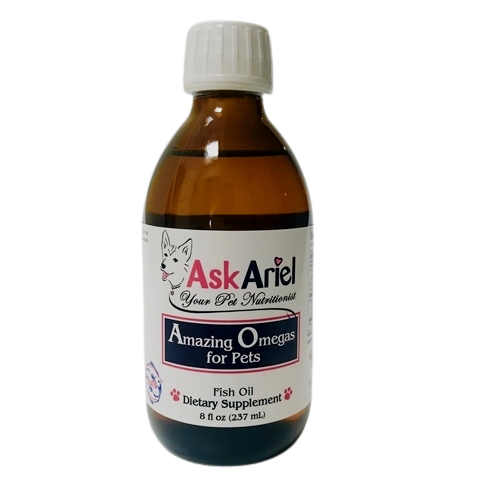 Amazing Omegas for Pets is a high-quality fish oil available for pets. It is a powerhouse of omega-3 nutrients (essential fatty acids) that can help your dog fight cancer. Amazing Omegas is a highly purified fish oil made from sardines, anchovies and mackerel, processed with minimal heat to preserve the oil in its natural state. It’s packed in glass bottles to prevent any chemicals from plastic leaching into the oil. It’s naturally processed and highly bioavailable, with all toxins and heavy metals carefully removed. Compare the nutrient panel of this premium dog fish oil to all other brands and see the difference. Amazing Omegas for Pets is a high-quality fish oil available for pets. It is a powerhouse of omega-3 nutrients (essential fatty acids) that can help your dog fight cancer. Amazing Omegas is a highly purified fish oil made from sardines, anchovies and mackerel, processed with minimal heat to preserve the oil in its natural state. It’s packed in glass bottles to prevent any chemicals from plastic leaching into the oil. It’s naturally processed and highly bioavailable, with all toxins and heavy metals carefully removed. Compare the nutrient panel of this premium dog fish oil to all other brands and see the difference.
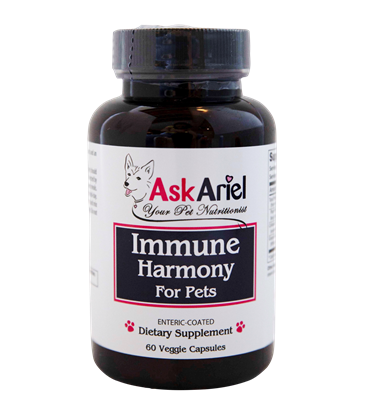 Immune Harmony is a premium-quality, patented blend of plant sterols and antioxidants. This pet vitamin has been successfully used in conjunction with chemotherapy and/or prednisone since 2005. The sterols contained in Immune Harmony have been shown in studies to have anti-inflammatory, anticancer and immunomodulatory properties. No known toxicity has been found. Immune Harmony is well-tolerated by even the smallest pets. The antioxidants protect the body from free-radical damage, and an essential fatty acid complex assists in the bioavailability of these health-promoting nutrients. It’s an excellent value: One bottle lasts between two and four months depending upon the weight of your pet. When looking for supplements for canine osteosarcoma, Immune Harmony is the first line of defense. Immune Harmony is a premium-quality, patented blend of plant sterols and antioxidants. This pet vitamin has been successfully used in conjunction with chemotherapy and/or prednisone since 2005. The sterols contained in Immune Harmony have been shown in studies to have anti-inflammatory, anticancer and immunomodulatory properties. No known toxicity has been found. Immune Harmony is well-tolerated by even the smallest pets. The antioxidants protect the body from free-radical damage, and an essential fatty acid complex assists in the bioavailability of these health-promoting nutrients. It’s an excellent value: One bottle lasts between two and four months depending upon the weight of your pet. When looking for supplements for canine osteosarcoma, Immune Harmony is the first line of defense.
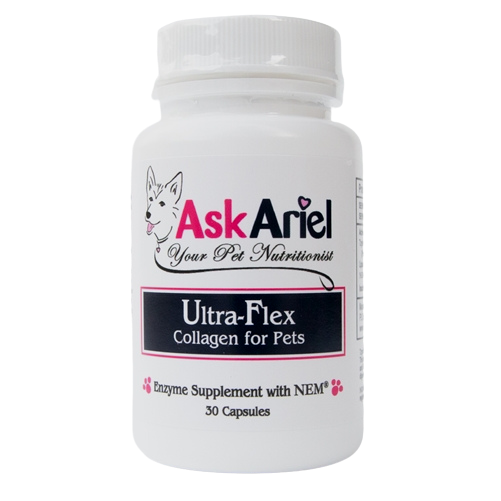 Ultra-Flex Collagen helps to build and protect ligaments and joints. A natural “whole-food” supplement that increases the elasticity and stability in the joints, muscles and connective tissue. Ultra-Flex Collagen For Pets contains NEM® brand eggshell membrane - a safe, all-natural whole-food source containing three varieties of collagen, glycosaminoglycans (GAGs) such as chondroitin sulfate, glucosamine, hyaluronic acid, and enzymes, which support joints and connective tissue. It contains key enzymes for enhanced absorption and bioavailability. Excellent choice for pets that are allergic to glucosamine or that are picky about herbal formulas. Especially important for dogs that have had a limb amputated. Ultra-Flex Collagen helps to build and protect ligaments and joints. A natural “whole-food” supplement that increases the elasticity and stability in the joints, muscles and connective tissue. Ultra-Flex Collagen For Pets contains NEM® brand eggshell membrane - a safe, all-natural whole-food source containing three varieties of collagen, glycosaminoglycans (GAGs) such as chondroitin sulfate, glucosamine, hyaluronic acid, and enzymes, which support joints and connective tissue. It contains key enzymes for enhanced absorption and bioavailability. Excellent choice for pets that are allergic to glucosamine or that are picky about herbal formulas. Especially important for dogs that have had a limb amputated.
What Is Canine Osteosarcoma?
Osteosarcoma is by far the most common bone cancer in dogs. It is most commonly found in large-breed dogs and usually occurs in middle-aged or elderly dogs, but it can occur in a dog of any age.
Tumors start deep inside the bone and grow from the inside out. Lameness and swelling increase as the healthy bone is destroyed. Most osteosarcomas in dogs are above the front knee or below the hind knee. Osteosarcoma on the limbs is called appendicular osteosarcoma. It is almost always a highly aggressive form of malignant cancer in dogs. Due to the aggressive nature of this disease, it metastasizes very rapidly, causing curative treatment to usually involve surgical removal of the tumor followed by chemotherapy. Canine osteosarcoma can also affect the jaws, ribs, skull or spine, but these axial sarcoma tumors tend to be slower-growing than the appendicular form.
Wyatt
"In February 2007, our precious Rottweiler, Wyatt, was diagnosed with bone cancer. The lesion was on his left front wrist. The life expectancy was 2 to 6 months so we set out to help make Wyatt comfortable. Amputation was not an option for him. We went to a cancer specialist and she suggested contacting Ask Ariel for nutritional support.
Ask Ariel suggested a terrific, high protein, balanced diet for Wyatt and helped us with his ongoing care. It was thorough, detailed and fit into our lives. Ask Ariel was always there if I had questions. Their knowledge and support was amazing.
Ch. Von Der Lors Wyatt Earp, CDX, RE, CGC, died on July 15, 2008. 17 MONTHS after his diagnosis and not from cancer. The cancer had progressed a bit, but still was contained in the area it had started. His oncologist said she could not ever remember seeing a dog do as well as Wyatt did without amputation. He walked 1/2 - 1 mile daily, swam often and had a full life up until 6 hours before we had to put him to sleep.
Wyatt was truly a miracle and Ask Ariel was part of that miracle. I know his diet and supplements played a huge part in his well being and beating the odds. We will always be grateful to Ask Ariel for helping Wyatt live life to the fullest. Every single day he found something joyful to do" - The Combs Family, California
Symptoms of Canine Osteosarcoma
The clinical signs of dog bone cancer depend on the tumor location. The most common signs are lameness and swelling at the tumor site. Symptoms of canine osteosarcoma may include:
- Neurological signs, such as seizures or wobbling
How Is Dog Bone Cancer Diagnosed?
Dogs with bone cancer in a limb may begin to walk with a limp and show distinct swelling at the tumor site. When viewing x-rays of bone cancer, the bone may look to be disintegrated or "moth-eaten" because the bone structure has deteriorated. These are called lytic lesions. Testing for bone cancer may include:
- Blood work & urinalysis
- X-rays and/or ultrasound
- Biopsy
There are other types of cancer, including chondrosarcoma or squamous cell carcinoma, that can cause lytic lesions. It is important to rule out fungal bone infections like San Joaquin Valley Fever (Coccidioidomycosis) which can also appear moth-eaten in x-rays. Complete diagnostic testing can help your vet or veterinary oncologist have a better idea of your dog's overall health. These tests can help show any preexisting arthritis or skeletal issues and can help to determine the type of bone tumor. Bone cancer in dogs shoulder or a dog hind leg canine osteosarcoma tumor are commonly mistaken for arthritis, especially in senior dogs.
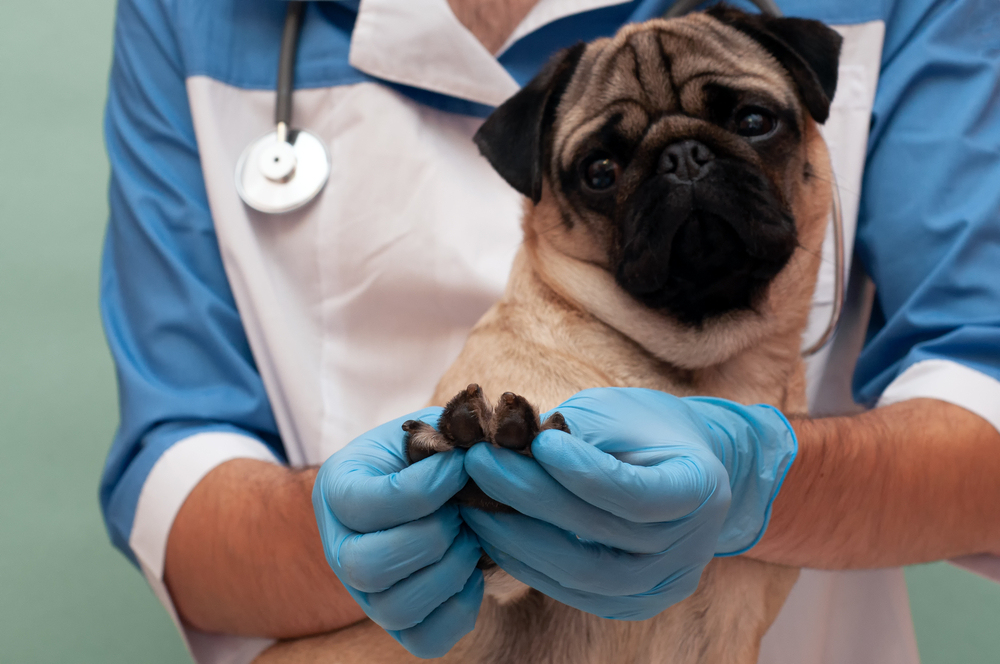
Dog Bone Cancer Treatment
You may have heard pet owners saying "my dog beat osteosarcoma" and you are searching for what can be done to help your dog. Traditional veterinary treatment for dog bone cancer usually includes limb-sparing surgery or amputation. If the tumor is localized to a small area and has not metastasized, it may be removed, preserving the limb. Amputation may be performed if there is a high risk of spread. Osteosarcoma is an aggressive form of cancer and almost 90% of dogs will have metastases to the lungs, other bones, or lymph nodes.*
*Reference: Research study. Resection of pulmonary metastases in canine osteosarcoma. Veterinary Surgery. M.G. O'Brien, R.C. Straw, S.J. Withrow, B.E. Powers, et.al.
Since dog bone cancer has a high recurrence rate, chemotherapy is usually recommended as a follow-up to bone cancer surgery. Did you know? Pets tolerate chemotherapy much better than people do and often display minimal if any side effects. Carboplatin is a common injectable chemotherapy drug that is often prescribed for dogs with bone cancer. Current research studies* on the chemotherapy drug Sorafenib (capsule taken at home) showed that the drug has potent antitumor activity on canine osteosarcoma cells in vitro. It shows potential as a dog bone cancer treatment. Traditional veterinary palliative care for your dog may include pain medications and radiation therapy to reduce the symptoms.
*The Tyrosine Kinase Inhibitor Sorafenib Decreases Cell Number and Induces Apoptosis in a Canine Osteosarcoma Cell Line. Research in Veterinary Science. Volume 88, Issue 1, February 2010.
Holistic treatments for dog bone cancer can be combined with most conventional veterinary options. Adding supplements for bone tumors in dogs, such as medicinal mushrooms, curcumin, CoQ10 and fish oil, can help your dog feel more comfortable. Simple diet changes can help to improve digestion and fight inflammation. At Ask Ariel, we will include FREE dog bone cancer diet tips on the packing slip that comes with your order.
How Long Can A Dog Live With Bone Cancer?
The average survival time for a dog with bone cancer depends on the type of cancer, the location of the tumor and the treatments selected. Dogs that do not receive surgery or treatment can expect to live 2-4 months. Dogs that have surgery along with chemotherapy live an average of 10 to 12 months. Whether your dog has surgery or not, supportive care using holistic cancer supplements and a dog bone cancer diet can improve the quality of life for your pet and, often, the quantity of time as well.
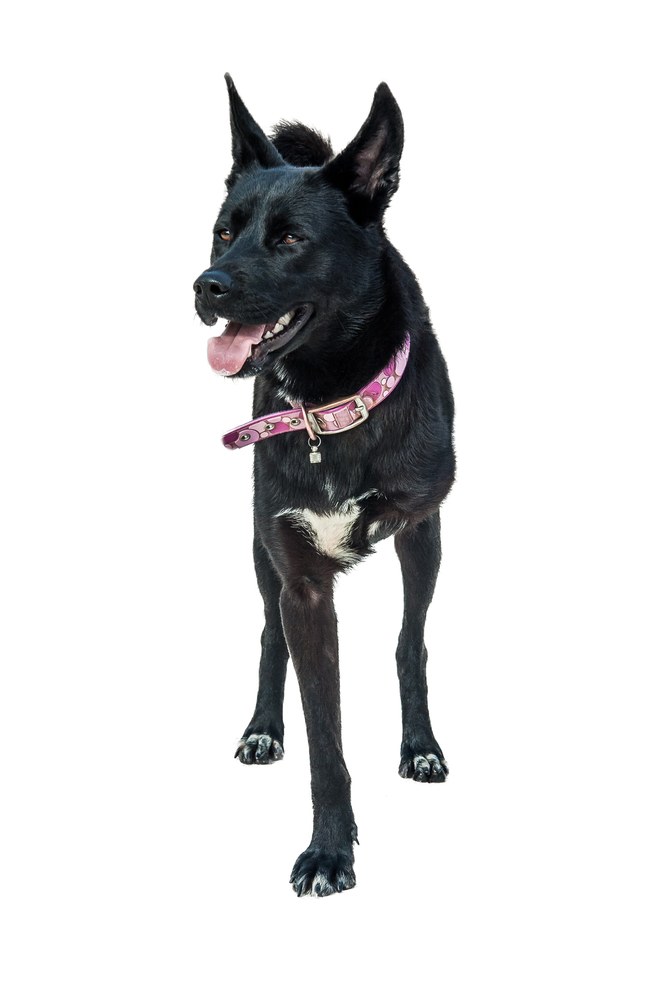
Tripods & Osteosarcoma In Dogs
Deciding to amputate a dog's leg because of osteosarcoma can be a very difficult decision. It is important to consider all of the positives and negatives for your dog. The age of your dog and its overall health (other than the cancer) are two of the most important determining factors. A senior dog with kidney disease may have a much more difficult recovery than a 3-year-old dog with no other health issues. The size of the tumor, location of the tumor and metastasis are other considerations. Bone cancer in dogs leg or bone cancer in dogs foot are much easier to treat surgically than bone cancer in dogs jaw.
Bone cancer causes excruciating pain and weakens the bones, making dogs more likely to fracture a leg. Deciding to remove a dog's leg is a palliative treatment for osteosarcoma. It relieves the pain. Amputation along with chemotherapy can give you more quality time with your dog.
Dogs can adjust to being tripods very quickly. They will need to learn how to distribute their weight and keep balance. Most dogs adjust very well. In many cases, they will run and play like before the amputation.

Pet Rehabilitation: Physical Therapy, Acupuncture & Chiropractic Care
Osteosarcoma can be a very painful type of cancer. Natural pet rehabilitation modalities, such as acupuncture, chiropractic, and cold laser, are natural ways to help reduce pain and enhance immune function for your dog. These treatments can be helpful for arthritis and osteosarcoma.
Many holistic veterinarians are now offering acupuncture and chiropractic care for their patients. The American Holistic Veterinary Medical Association ahvma.org can help you find a holistic veterinarian that specializes in acupuncture or rehabilitation therapy.
The Best Diet for Dogs With Osteosarcoma
Another important part of a comprehensive canine osteosarcoma natural treatment is diet. Pets with cancer need a special cancer diet that supports a healthy immune system and reduces inflammation. Dogs with osteosarcoma can benefit from a low-carbohydrate diet that is rich in Omega-3 fatty acids. Diets high in carbohydrates may promote tumor growth and should be limited. Dry food diets generally are high in carbohydrates so choosing another form of dog food such as raw frozen, canned or homemade can be beneficial. Adding an array of fresh vegetables can provide important enzymes and nutrients to your dog's diet. Ask Ariel has extensive experience formulating diets for pets with cancer as our Pet Nutritionist Susan Davis offered holistic consultations for over 10 years at VCA hospitals and at a veterinary oncology clinic. While we no longer offer consultations, we do include FREE dog bone cancer diet tips on the packing slip that comes with your order.
Need Help?
If you have questions about our supplements for bone tumor in dogs, please feel free to email us at [email protected]. We will be happy to provide you with additional information about our natural remedies for osteosarcoma, but please know that due to veterinary regulations, we cannot provide individualized consultative advice without a physical exam.
|
|
|
How long can dogs live with osteosarcoma?
The earlier the cancer is detected, the better chance your dog has at fighting the disease. If you notice any signs of canine osteosarcoma such as limping, a swelling or mass, please take your dog to the veterinarian right away. The average life span for a dog with bone cancer will depend on the spread of the disease and the treatments chosen. Dogs that have a limb amputation or limb-sparing surgery and receive chemotherapy can generally live for about 1-2 years. In some cases, dogs can survive 5-6 years after the initial diagnosis when they are treated with surgery and chemo. Dogs that receive palliative radiation and chemotherapy care with no surgical intervention have an average life expectancy of 6 months. Dogs that do not receive palliative therapy or surgery can generally expect to live for only a few months. Osteosarcoma is a very painful cancer, so it is important to provide your dog with natural pain relief and anti-inflammatory supplements to help keep them comfortable.
What are the first signs of osteosarcoma in dogs?
The first sign of osteosarcoma in dogs is usually lameness of the affected area. Dogs will start to limp and become painful to the touch. The tumors start deep within the bone, so the cancer can be fairly advanced before obvious symptoms appear. Other common signs of bone cancer in dogs may include: joint pain, swelling, loss of appetite and lethargy. In many cases, the pain seems to improve with the introduction of pain medications and anti-inflammatories, but often this relief is short-term. Using natural pain management supplements in conjunction with veterinary prescriptions can help provide relief without the risk of serious side effects.
How painful is osteosarcoma in dogs?
Osteosarcoma is a very painful cancer. The tumors destroy the healthy bone and cause bone destruction (osteolysis). As the bone becomes weaker, your dog will become less weight-bearing on the affected limb and at greater risk of fractures. Veterinarians usually prescribe multiple pain medications and NSAIDs to relieve the pain. Along with medications, natural pain relief supplements can help to reduce the pain and inflammation. Many natural supplements, like curcumin, fish oil and hemp extract, can be used in conjunction with most prescriptions from your vet.
How can I help my dog with osteosarcoma?
The standard veterinary treatments for canine osteosarcoma include surgery (amputation or limb-sparing surgery), radiation, chemotherapy or a combination of these treatments depending on where the tumor is located and if it has metastasized. Due to the aggressive nature of osteosarcoma, the most common veterinary approach is tumor removal or amputation. Most dogs feel relief once the painful tumor or limb is removed. If surgery is not an option, palliative care with chemotherapy or radiation may be elected to alleviate the pain and swelling. It is important to individualize the treatment to provide the best option for the dog. Using holistic treatments, along with conventional veterinary care, in the form of supplements and an osteosarcoma diet plan, can help to improve your dog’s quality of life and may extend survival time.
|
|
|